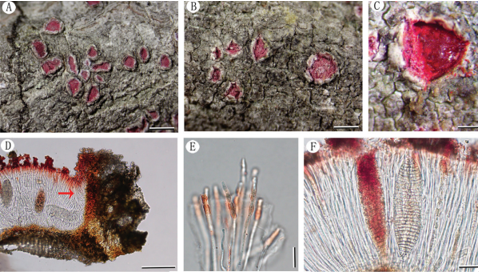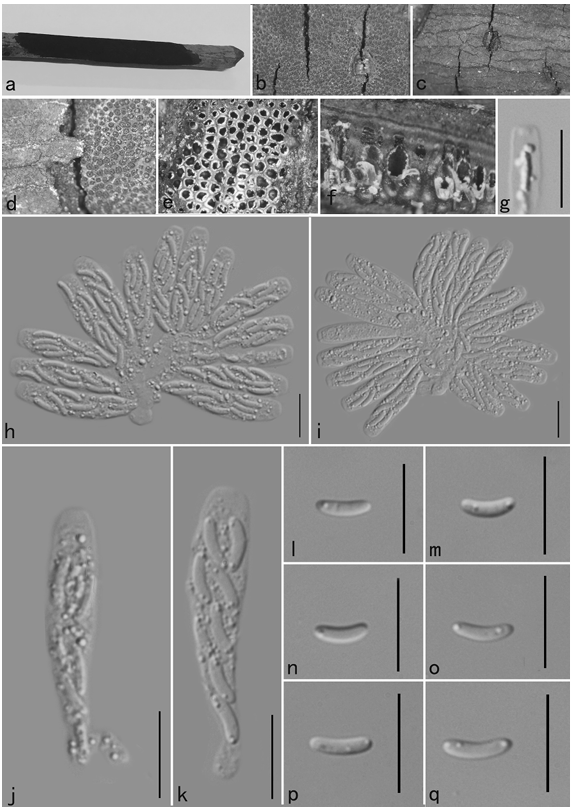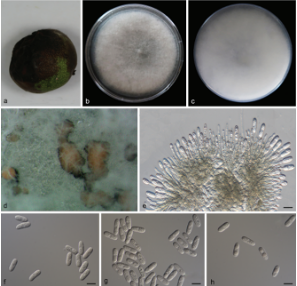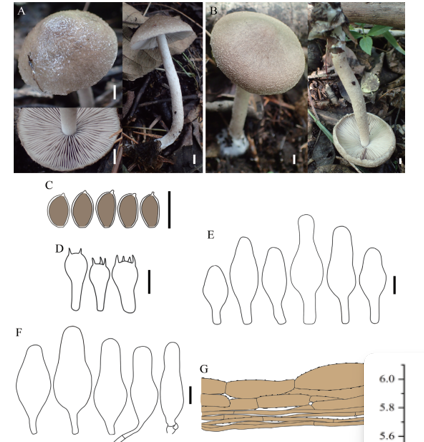Dothiorella alpina (Y. Zhang ter & Ming Zhang) Phookamsak & K.D. Hyde, comb. nov. 2020
Index Fungorum number: IF55723; Facesoffungi number: FoF07384
Holotype: China, Yunnan Province, Kunming City, Kunming Institute of Botany, on dead stolon of Ipomoea sp. (hanging on the tree), 18 October 2016, R. Phookamsak, KIB008 (KUN-HKAS 102212, new host record), living culture, KUMCC 18–0135, KUMCC 18–0136.
Morphological description
Saprobic on dead stolon of Ipomoea sp. Sexual morph: Undetermined. Asexual morph: Conidiomata 135–245 µm high, 150–235 µm diameter, pycnidial, immersed, raised, becoming erumpent through host epidermis, gregarious, visible as black, gnarled with dark area on host, globose to subglobose, 1-loculate, occasionally developed hyaline, palisade-like invaginations, raising from basal cavity, ostiole central, with a small, narrow papilla. Pycnidial walls 15–30 µm wide, composed of 3–5 layers, of large, dark brown to black pseudoparenchymatous cells, arranged in textura angularis to textura globulosa. Conidiophores reduced to conidiogenous cells. Conidiogenous cells 7–10 × 2–4(–5) µm (x̄ = 8.9 × 3.6 µm, n = 30), raising from the inner cavity, enteroblastic, phialidic, integrated, determinate, ampulliform to cylindrical, unbranched, aseptate, hyaline, smooth, with minute collarette, with thin periclinal wall thickening. Conidia 22–25(–28) × 10–12(–13) µm (x̄ = 24.4 × 11.1 µm, n = 50), initially hyaline, becoming brown to dark brown when mature, oblong with rounded ends, occasionally irregular in shape, 1-septate, smooth-walled. Culture characteristics – Colonies on PDA fast growing, reaching 50 mm diameter after 1 week at 20–25°C, colonies initially medium sparse with aerial mycelia, white grey, becoming dense, with hyphal lumps, circular, flat, surface smooth with edge entire, margin well defined, cottony to fluffy; colony from above and below, black with white to black hyphal lumps; not producing pigments on PDA.
Habitat: on dead stolon of Ipomoea sp
Distribution: China
GenBank Accession: ITS MT002267 ;LSU MT002266 ;SSU MT002268 ;RPB2 MT005773 (KUMCC 18–0135) ;ITS MT000718 ;LSU MT000720 ;SSU MT000725 ;RPB2 MT005774 (KUMCC 18–0136).
Notes: The NCBI BLASTn search of ITS sequence data shows that our strains (KUMCC 18–0135, KUMCC 18–0136) are identical to Spencermartinsia sp. ‘alpina’ strain CGMCC3.18001 and Spencermartinsia sp. JC-2017 strain CFCC 51564 (as Dothiorella magnoliae; You et al. 2017) with 100% similarity. Phylogenetic analyses of a concatenated ITS and tef1 sequence dataset indicated that our strains have a close affinity with S. alpina (CGMCC3.18001) with strong support (97% ML and 1.00 PP, Fig. 106). Morphological characters and phylogenetic analyses indicated that our collection is conspecific with S. alpina (Zhang et al. 2016). We, therefore, transfer S. alpina to Dothiorella. A new combination, Dothiorella alpina is designated and is reported from Ipomoea sp. in Yunnan, China for the first time.
Reference: Hyde KD, de Silva NI, Jeewon R et al. 2020 – AJOM new records and collections of fungi: 1–100. Asian Journal of Mycology 3(1), 22–294, Doi 10.5943/ajom/3/1/3 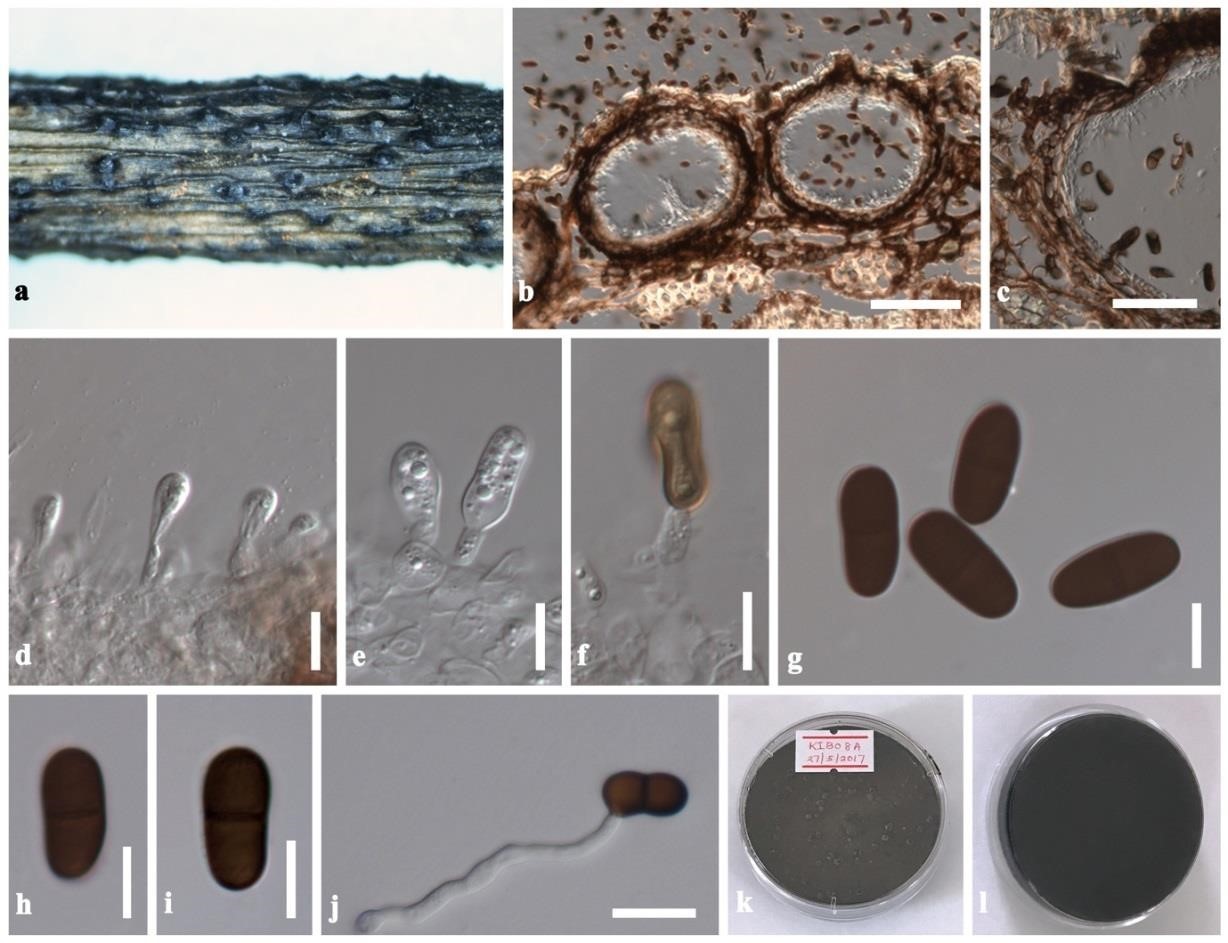
Dothiorella alpina (KUN-HKAS 102212, new combination). a Appearance of conidiomata on host substrate. b Section through conidiomata. c Section through pycnidial wall. d–f Conidiogenous cells with the development of conidia. g–i Conidia. j Germinated conidium. k, l Culture characteristics on PDA (k = from above, l = from below). Scale bars: b = 100 µm, c = 50 µm, d–f, j = 20 µm, g–i = 10 µm.


